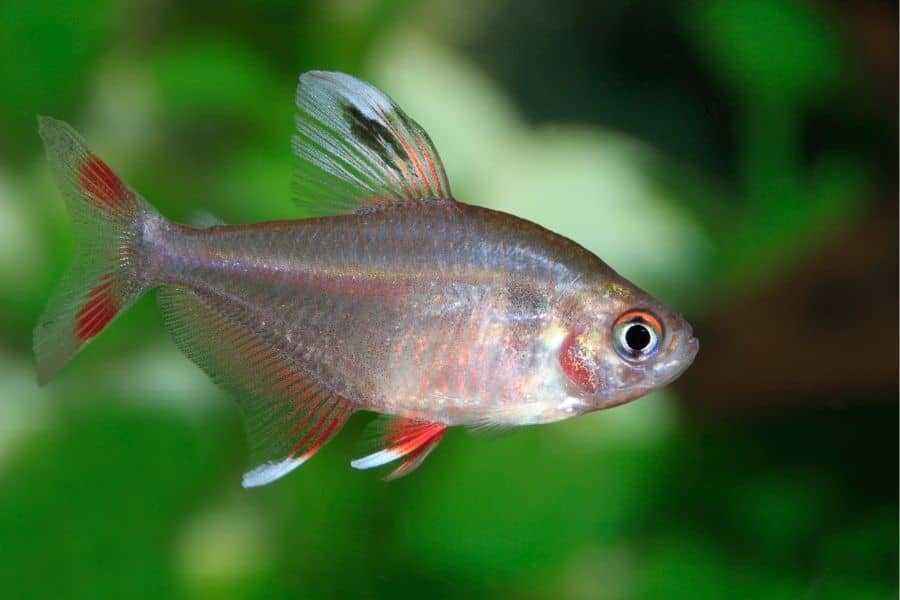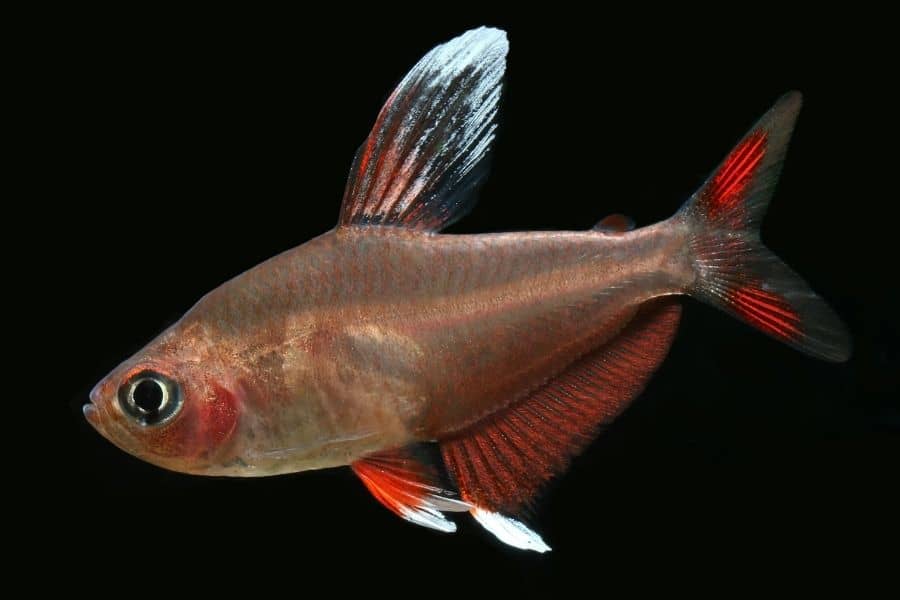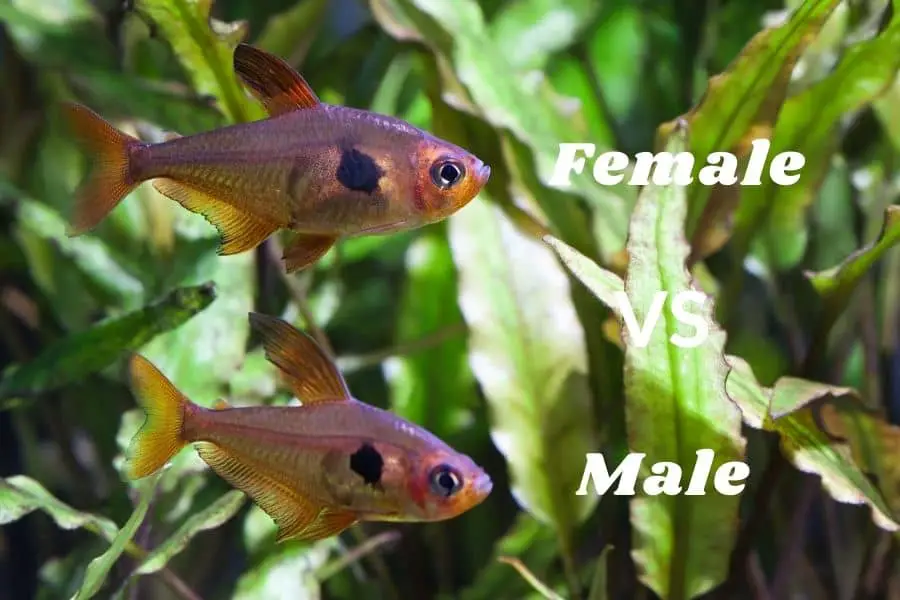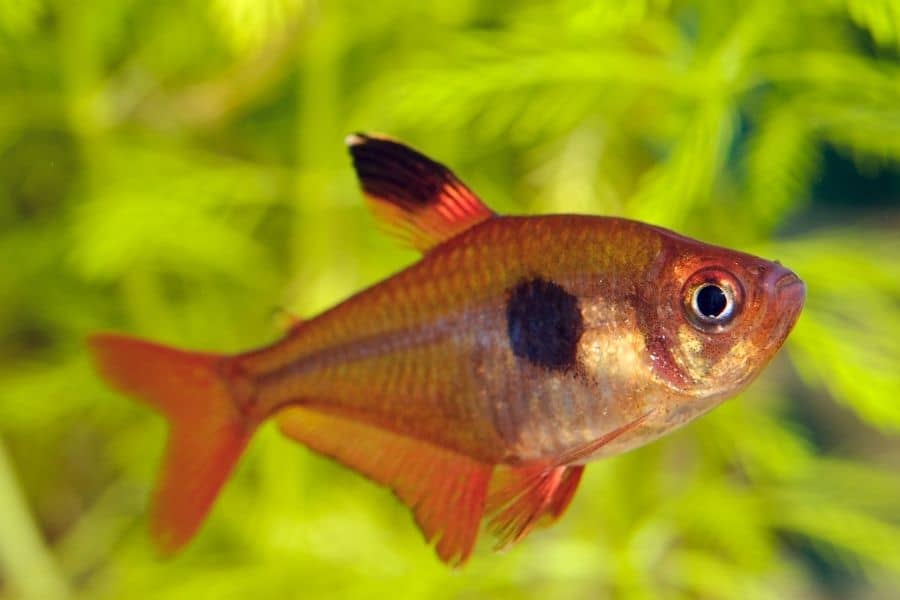Rosy Tetra is a peaceful fish that makes a great addition to a community tank. It is a hardy fish that can adapt to many water conditions, making it a beginner-friendly fish.
They are very popular among fish keepers because of their fun and cool look and their cheerful behavior.
In this article, I’ll answer all your questions regarding Rosy Tetra. Hopefully by the end of the article, you’ll feel confident adding them to your collocation.
What Is Rosy Tetra?
Jump To

Scientifically known as Hyphessobrycon rosaceus, Rosy Tetra is a small-sized fish originate from South America.
They are a peaceful schooling fish and easy-to-care species, which is suitable for beginner fish keepers. It has the deep-bodied shape of larger tetras, like the Bleeding Heart Tetra.
Rosy Tetra has a light pink, and salmon-colored body highlighted with red fins with bright white tips.
The dorsal fin of this fish is usually red and black, but it can be red and white, like pelvic fins and anal fins. The caudal fin is pink-white with two elliptical red spots on it.
Because of its look, Rosy Tetra is also known as Rosy fin tetra, White-Finned Rosy Tetra, and Rosey Tetra.
How Big Do Rosy Tetra Get?
Rosy Tetra is a very small fish that grows up to 1.6 inches (3.99cm) in captivity. However, they usually grow up to 2.5 inches in the wild.
Is Rosy Tetra Aggressive?
Rosy Tetra is a peaceful ish species. However, if you keep them with semi-aggressive or aggressive fish species, they will be fierce. They can live well with peaceful and non-fin nipping tank mates.
Behavior
Rosy Tetra is a peaceful, colorful, and active fish species that goes well with a peaceful community tank. They are shooling fish that school together in a group.
So, if you want them to be nice in a tank, you need to keep at least six fish together. They will happily school with other tetra species such as Ornate Tetra, Black Widow Tetra, White Skirt Tetra, and Bleeding Heart Tetra.
Rosy Tetras are non-venomous and can be kept safely with shrimps, crabs, snails, slow swimming fish, and slow eating fish. They are omnivore fish species but love to eat live food more than plants.
Rosy Tetras will occasionally eat plants and algae but will not harm the plants.
You should never keep Rosy Tetras with semi-aggressive, aggressive, large semi-aggressive, large aggressive, and predatory fishes.
Rosy tetras will become aggressive with aggressive tank mates and become prey for predators because of their small size.
Rosy Tetra Lifespan:
Rosy Tetras have a life span of about 3 to 5 years.
ONE LOOK CARE GUIDE
| Scientific name | Hyphessobrycon rosaceus |
| Common name | Rosy Tetra, Rosy Fin Tetra, White-Finned Rosy Tetra, Rosey Tetra |
| Care level | Moderate |
| Native to | South America, lower Amazon River Basin of Guyana, Suriname, and Brazil |
| Type (soft or hard coral) | |
| Color | deep salmon-colored body with red accents and bright white or black tips on the fins |
| Tank size | 15 gallons |
| Preferred temperature | 23.9 – 27.8° C ( 75.0 – 82.0° F) |
| Other water parameters (ammonia, etc.) | pH 5.5 to 7.5, 5 Hardness 5 – 19 dGH. Ammonia – 0, Nitrate – 0, Nitrite – 0, Salinity – 0 |
| Preferred salinity | Can not live in Brackish Water |
| Size | 1.5 Inches |
| Growth rate | Around 6 months to fully grow |
| Temperament | Peaceful |
| Recommended tank mates | Non Aggressive peaceful Species |
| Preferred food | Flakes, Pellets, Live food, Frozen meaty food |
| Feeding frequency | Several Times per Day |
| Breeding | Egg Scatterars, Spawn frequently, Bad parents |
Rosy Tetra Care
Caring for Rosy Tetras is pretty straightforward. They can adapt to various water conditions. Therefore, they are beginner-friendly. You need to give a varied diet to Rosy Tetras and provide plenty of space to thrive. Let’s discuss their exact needs below.

Rosy Tetra Size
Rosy Tetra has a deep body with the shape of some larger tetras like Bleeding Heart Tetra. Rosy Tetra will generally reach about 1.5 inches and will live for about 3 to 5 years.
Rosy Tetra Tank Size
Although Rosy Tetras are quite small, they need at least a 15-gallon tank to thrive. That is because they are schooling fish and tend to live in a group. You need to put at least 6 Rosy Tetra in a tank for them to live happily. The minimum tank size we mentioned here is for 6 fish.
How Many Should Rosy Tetra Be Kept Together?
As Rosy Tetra is schooling fish, you should keep at least 6 fish together. Otherwise, they will get stressed, hence become more prone to diseases.
Tank Setup
Rosy Tetra’s natural habitats are heavily forested, sluggish tributaries off of main rivers in South America. They prefer an environment that resembles their natural habitats.
You should provide dim lighting as they used to live in backwater with dense forest cover. For the substrate, it’s best to use river sand because sand provides them a natural feeling.
The Aquarium should be heavily planted in the back and sides and have plenty of space to swim freely.
You should provide at least 15 gallons of water for 6 Rosy Tetras to thrive. More is better. The tank should have a high-quality filter that doesn’t create too much current as this fish prefers sluggish water.
To stimulate black water conditions of their habitats, you can attach Aquarium-safe peat to the filter.
You can add a handful of dry leaves to the tank to give them a more natural feel. However, remember to replace the dry leaves every few weeks. Rosy Tetras prefer Woodwork and floating plants.
So, be sure to add these decorations to your Aquarium. They also need plenty of hiding places. Therefore adding scattered driftwood and twisted roots is recommended.
As Rosy Tetras are schooling fish, they will inhabit all areas of the Aquarium. But they usually spend their time in the upper and middle region of the tank.
So, be sure to keep plenty of free space in these areas.
Water Quality Condition
Rosy Tetras are relatively hardy fish that can adapt to different water conditions. The waters they inhabit usually are stained brown and very acidic. So, if you can provide those water conditions, they will thrive well.
Rosy Tetras can live in temperatures between 75.0 to 82.0° F and need slightly warm water to breed. Their breeding temperature is 80 to 82° F.
Preferred Ph range is 5.5-7.5. Rosy Tetras can live in alkaline water but will be more colorful if you provide them with acidic water like their inhabits. The water hardness level is 5 – 19 dGH.
Rosy tetras can not live in Brackish water and need slow to no movement in the water.
Special Tips
As your Aquarium is a closed system, it needs maintenance to keep the Aquarium clean and out of toxic nutrients.
You need to eliminate organic matter decomposition to ensure clean water without any harmful chemicals to the fish, such as Nitrates, Nitrites, and Ammonia.
For that, you need to install a good aquarium filter and do at least 10% water change each week. Using an aquarium vacuum cleaner is the best option to do a water change as well as to remove the remaining debris on the bottom of the tank.
Although Rosy Tetras can live in various water conditions, they can not tolerate sudden changes such as sudden temperature change, habitat change, etc.
So, take measures to control water conditions at a steady level to avoid unnecessary stress in your fish.
Rosy Tetra Breeding
Rosy Tetra is an egg scattering and school pawning fish. They don’t care about their babies and tend to eat eggs and fry. Because of this behavior, breeding Rosy Tetra is tricky.
However, there’s no need to condition the fish before breeding, as they naturally breed when they are together.
You just have to save the eggs and fry from adult fish. Let’s learn how to breed Rosy Tetra.
Identify Female Rosy Tetra
When breeding Rosy Tetra, identifying females and males is essential to pair them up. Females are usually rounder than males, and their body is less colorful.
But there are some more differences between Rosy Tetra Male and females.
Rosy Tetra Male Vs. Female Differences
Rosy Tetra Males have longer dorsal fins than females, and they are brightly colored than females.
Male fish is usually more petite and slender than females. Females are generally rounder, and the belly gets enlarged when they are ready to spawn.
On the other hand, male Rosy Tetras leave small bubbles inside the Aquarium, indicating they need female fish to breed.

How To Breed
Breeding Rosy tetra is relatively easier than fish who needs conditioning like tiger barbs. You just have to identify male and female fish and put 3 to 4 pairs into the breeding tank when the fish show signs of reproduction.
When Rosy Tetras are ready to breed, male fish leave a small bubble inside the tank, and female fish gets more rounder. If you don’t put them into a separate tank, they will breed inside the Aquarium, leaving the eggs at risk.
Rosy Tetras are terrible parents that they tend to eat their own eggs and fry. That is why you should put the adult fish into a separate tank if you need any Rosy Tetra Babies.
Rosy Tetras are egg scattering spawners, so the females will release their eggs while males fertilize the eggs with their sperms when spawning.
The fish eggs fall to the bottom of the tank, and the adult fish will eat the eggs after spawning. You need to take the adult fish back to your Aquarium as soon as the fish finishes spawning to save the babies.
The breeding tank of Rosy Tetras needs to be at least 10 gallons with fairly soft water. The temperature should be slightly warm between 80 to 82° F. The water should be slightly acidic with a pH of 6.5 to 7 and a hardness of 4° dGH or less.
You should add fine-textured live plants and provide dim light to induce spawning. Install a small, air-powered sponge filter to filter the water, provide oxygen, and provide gentle water flow.
Gentle water current and low lighting will mimic Rosy Tetra’s natural habitats so that they will comfortably spawn in there.
To optimize the breeding success, you can condition male and female Rosy Tetras in separate tanks before breeding.
While conditioning, you should feed them with plenty of small live foods such as brine shrimps, tubifex, or bloodworms. When the fish are ready for breeding, females get a more rounder belly full of eggs, and males leave small bubbles in the Aquarium.
Choose the most colorful males and females that are most rounder.
Rosy Tetras typically spawn in the morning. The females usually release the eggs among fine-leaved plants. You should remove Rosy Tetra’s parents immediately after spawning, or the adult fish will eat the eggs. Eggs typically hatch within 24 to 36 hours, and the fry will be free-swimming after about 5 days.
How Many Babies Does Rosy Tetra Have?
Female Rosy Tetras usually lay about 60 to 130 eggs at a time. So, if you prevented eating eggs, you can expect around 40 to 100 babies from one fish pair.
How To Care for Fry
When fry starts to swim around the tank freely, you should begin feeding them fry food such as infusoria or deep-boiled egg yolks.
When the fry gets bigger, you can start feeding them with microworm or brine shrimp nauplii. You should keep baby fish isolated from adult fish until they have grown large enough that the adult fish can not eat them anymore.
You should perform water changes from small fry age to the day you introduce the baby fish to your Aquarium. And you should do it very carefully.

How To Feed Rosy Tetra?
Rosy Tetras are Omnivore fish. They need a balanced diet with more vitamins. They like to chase live food, so you should combine their regular feedings with some live foods to thrive.
What Do Rosy Tetras Eat
Rosy Tetras eat both plant matter and meat matter. They mostly eat live foods as they love to chase live foods. However, they also eat plants and algae occasionally.
What Do Rosy Tetras In The Wild?
Rosy Tetras usually eat small insects, crustaceans, and live worms in the wild, as this food is readily available in their habitats due to dense vegetation. Additionally, they eat live plants and algae in the wild.
What To Feed Rosy Tetras In The Aquarium
You can feed flakes, plant-based and protein-based foods, live foods, blood worms, dried blood worms, brine shrimp, etc., in the Aquarium. Their diet should make up 60% to 80% high-quality flake food along with live or frozen protein-based foods as snacks.
How Long Can Rosy Tetras Go Without Food?
As Rosy Tetras are small fish species, they can not survive for long without food. They usually can survive up to 10 days without any food. They will die if left starving for more than 10 days.
When To Feed
You should feed Rosy Tetras several times per day for up to 3 minutes each time. Maintain a good feeding frequency to avoid overfeeding and always remove any excess food after 3 minutes of feeding.
How Much To Feed
Put as much food as you think your fish will eat, and remember to remove the leftovers after 3 minutes. Rosy Tetras will eagerly eat everything you offer them, so you should be careful not to leave any food for more than 3 minutes. Otherwise, they will over-eat, and it will cause them stomach problems which may lead to death.
Related :Black diamond stingray (Potamotrygon leopoldi) | beginners care guide |
Related :Guide On What Black Skirt Tetras Eat & Black Skirt Tetra Care?
What Fish Can Live With Rosy Tetra?
Rosy Tetra is a peaceful and active fish species that is excellent for a community aquarium. However, their friendly behavior isn’t always true, especially when they are with aggressive fish species.
You can choose any fish that is peaceful, and your Tetras will get along with them just fine. However, you should keep at least 6 Rosy Tetras together to avoid fin nipping and territorial behavior.
If you own fewer Rosy Tetras in a tank, they will show some aggressive behavior because they need accompany of a group.
Rosy Tetras usually do best with similar-sized peaceful species like small fish, shrimps, Crabs, Snail, small rasboras, barbs, and dwarf cichlids.
They can do well with peaceful South American species like pencil fish and small Loricariids.
Rosy Tetras can also live peacefully with slow eaters and slow swimmers. Tetras will not cause any trouble for them.
What type of fish to avoid?
Do not keep Rosy Tetras with larger fish that are omnivore or carnivore. They will see Rosy tetras as food, and Tetras will become prey.
You should also avoid semi-aggressive and aggressive fish species like Bettas and cichlids because Rosy Tetras will become aggressive with aggressive tank mates.
What about plants?
You can grow aquatic plants with Rosy Tetras safely. Although Rosy Tetras eat plants, they don’t eat plants to the extent that the plant dies. Rosy Tetras prefer live food rather than plants. So, your plants will be safe as long as you feed them with a proper diet.
Rosy Tetra And Angelfish
Although Angelfish is an aggressive type of fish, they won’t bother other fish as long as the conditions are met. Rosy Tetras are schooling fish so that they will stay in the group most of the time.
However, if your Angelfish is a matured one and Rosy Tetras are still small, you should avoid keeping them together.
Otherwise, your tetra will be food for your Angelfish. And you don’t need that. Right?
Rosy Tetra Shrimp
Rosy Tetrasand Shrimps match perfectly together. Rosy Tetras are fish that explore everywhere, especially in the middle of the tank.
But, shrimps just stay on the bottom, feeding the leftover foods and cleaning the tank. Both species don’t disturb each other so that they can live in one tank without any problems.
Rosy Tetra And Betta
Rosy Tetra and Betta are not a good match. Betta is an aggressive fish species that nip at other long-finned fishes.
They are so territorial, and Rosy Tetras don’t like that. If you keep both fish in one tank, they will start to fight with each other. And you don’t want violence in your Aquarium. Right?
Also read : Vampire Tetra (Hydrolycus scomberoides) Care & 15 Things Must know
Related Questions
White Spots On Rosy Tetra
White spot disease is a common disease of aquarium fish. Most commonly known as Ich or Ick, this disease is caused by ciliate protozoan Ichthyophthirius multifiliis.
When fish is infected with Ich, they develop small, blister-like small lesions on the skin and fins. These lesions look like white spots, and it is highly contagious.
The mortality rate of this disease is very high, so immediate treatment is needed.
Yellow Spots On Rosy Tetra
Yellowish, goldish, or brownish spots on Aquarium fish sometimes occur because of Velvet disease. It’s a tiny parasite called Oodinium, and it uses light to live.
So, if your fish is infected with Velvet, you can cure them by covering the tank with black paper or cloth for a while.
Full Grown Rosy Tetra Size
A full-grown Rosy Tetra size is about 1.5 inches. They are smaller than most other aquarium fish like Guppies, Mollies, and Bettas.
But, they look so colorful, and they are a very active and cheerful fish species you wouldn’t want to miss.
Rosy Tetra Eat Plants
Rosy Tetras eat plants. But they don’t destroy the plants by eating all the leaves.
Plants are just an occasional part of their diet besides their main diet of flakes, pellets, and live food. So, you can safely grow plants in your Aquarium with Rosy Tetras.
Rosy Tetra Vs Neon Tetra
Rosy Tetras go very well with other Tetra types. They are actually the best tank mates you can keep with Rosy Tetras. You can see Rosy Tetras and Neon Tetras swim together in a school if you put Rosy Tetras with Neon Tetras.
Both fish species are peaceful and compatible with other peaceful fish species. So, you can keep Rosy Tetras and Neon Tetras together with many different small Tetra types.
Related Ultimate Guide On What Cardinal Tetras Eat And Cardinal Tetra Food?
Related Black Neon Tetra Care Guide | 10 Things Must Know
Related Do Danios Eat Plants? | Unusual Facts
Source
Team, T.F.K., Tropical Fish Keeping-Aquarium fish care and resources» Reference Material» Freshwater Fish Profiles» Characid Species» Rummynose Tetra, Brilliant Rummynose Tetra (Hemigrammus bleheri).
